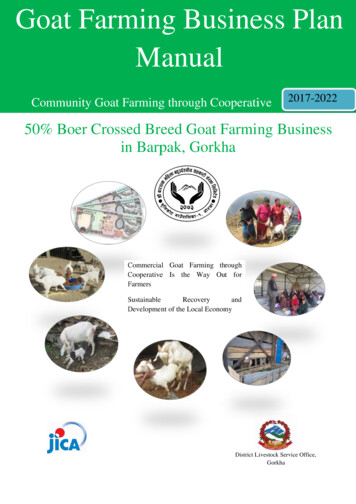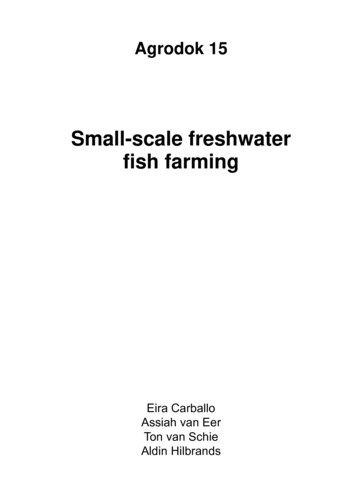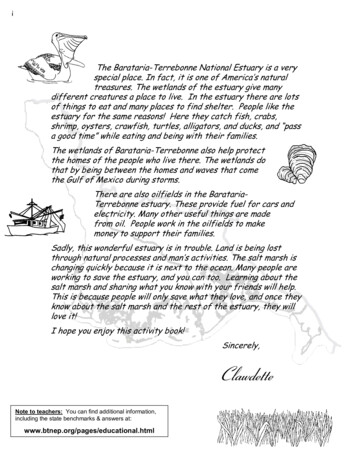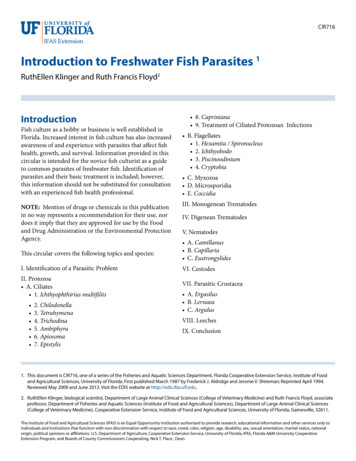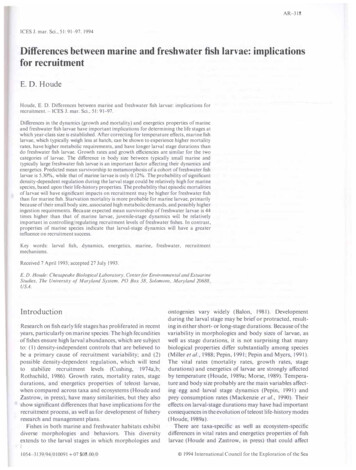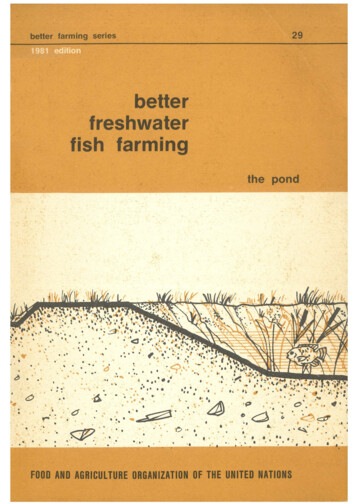
Transcription
29better farming seriesbetterfreshwaterfish farmingthe pond. . ' . . . . '. . ' . . . . ,. ,. . . .'. .' "\I .0 . . .·. '"""' . ., 4. . . .et?.' .·. ''. . . . ,p. . · . ' '·&) . e 2 . . ' ·C . '. . . . ' . ' . .o.I tC,1; . .1FOOD AND AGRICULTURE ORGANIZATION OF THE UNITED NATIONS.,'&'·---·
BETTER FARMING SERIESTwenty-nine titles have been published in this series, designed as handbooks for agricultural education and training.They may be purchased as a set or individually.FIRST YEAR1.2.3.4.5.6.7.8.9.The plant: the living plant; the rootThe plant: the stem; the buds; the leavesThe plant: the flowerThe soil: how the soil 1s made upThe soil: how to conserve the soilThe soil: how to improve the soilCrop farmingAnimal husbandry: feeding and care of animalsAnimal husbandry: animal diseases; how animalsreproduceSECOND 5.26.27.28.29.The farm business surveyCattle breedingSheep and goat breedingKeeping chickensFarming with animal powerCerealsRoots and tubersGroundnutsBananasMarket gardeningUpland riceWet paddy or swamp riceCocoaCoffeeThe oil palmThe rubber treeThe modern farm businessFreshwater fish farming: how to beginWater: where water comes fromBetter freshwater fish farming: the pond
better farming series29Betterfreshwaterfish farmingthe pondFOOD AND AGRICULTURE ORGANIZATION OF THE UNITED NATIONSRome 1981
FAQ Economic and Social Development Series No. 3!29First printing 1981P-69ISBN 92-5-1 011 27-3 FAQ 1981
PREFACEThe FAO Better Farming Series is essentially based on theCours d'apprentissage agricole prepared in thf Ivory Coastby the lnstitut africain de developpement economique et social for use by extension workers in contact with illiterate orsemi-literate farmers. The approach is deliberately a generalone, the intention being to constitute basic prototype out lines, to be supplemented in each area according to localconditions of agriculture.Many of the booklets deal with specific crops, while others,such as this one, are intended to give the farmer informationconcerning the general agricultural context, and thus to allowhim to gain some understanding of why he does what he doesso that he will be able to do. it better.Adaptations of the series, or of individual volumes in it, havebeen published, among others, in Amharic, Arabic, Bengali,Creole, Hindi, lgala, Indonesian, Kiswahili, Malagasy, SiSwatiand Turkish. This impressive list is some indication of thesuccess and also of the value of the series. This volume hasbeen prepared by the Inland Water Resources and Aquaculture Service, Fishery Resources and Environment Division ofthe Food and Agriculture Organization of the United Nations.Requests for permission to issue this manual in other languages and to adapt it according to local climatic and ecological conditions are welcomed. They should be addressed tothe Director, Publications Division, Food and Agriculture Organization of the United Nations, Via delle Terme di Caracalla,00100 Rome, Italy.
OUTLINE OF THE COURSE Improving your fish farm.3 Planning a bigger pond . . . . . . . . . . . . . . . . . . . .7Where to put your pond.Water . "Place . . . . . . . . . . . . . . . . . . . . . . . . . . . . . . . .Soi I . . . . . . . . . . . . . . . . . . . . . . . . . . . . . . . . . .Testing soil . . . . . . . . . . . . . . . . . . . . . . . . . . .How large should your pond be?.779Oilc Building a bigger pond 1111 " 1o1114.18How to make your old pond bigger . . . . .How to build a new, bigger pond . . . . . . .The in let . " " . . . . . . . . . . . . . . . . . . . . . . . . .The outlet . . . . . . . . . . . . . . . . . . . . . . . . . . . .A better outlet . . . . . . . . . . . . . . . . . . . . . . . .The overflow . . . . . . . . . . . . . . . . . . . . . . . . . .A siphon . " . "' . . . . . . . .Screens1820293134353841All 1
IMPROVING YOUR FISH FARM1.You have already built the small ponddescribed in Booklet No. 27,Freshwater fish farming: how to begin,and you have grown many fish in it/:·, .· I1' ,. ' '. . . .2.Your family would like to have more fish to eat,and you have fearned at the marketthat you can sell more fish if you have them.3.You would like to grow more fish to eatand to sell at the marketso that you and your family can live better.Growing more fish is improving your fish farm.3
4.You can imby making :;ove your fish farmIf your old po old pond bigger.was 10 byou can : n:etres,by moving soe it twice as bigof the banks .You can makem:tI 10 b Y 2 O metres. .5. .You ea n ·improvby building a e your fish farm·eithernext to newy , b',gger fish pondour old pond . .-.---.1,,, . .--,. :·,··r., . : . -,;; 11/A\ tfu wn11Y/ ,. .'4. . .
or in another place.You can improve your fish farmby building more than one pond.6.But start slowly and carefully.First, build only one new pond.After you have builtyour first bigger pondand you know how to use itto grow more fish,you can build more pondsand grow fish all year round.7.After you have builtone or more new, bigger ponds,you will need more baby fishthan you did before.You may decide to growyour own baby fishso that you will have themwhen you need them.8.This is another wayof improving your fish farm.You will learn more about itin Booklet No. 30.5
9.Before you beginto improve your fish farm,you must be sure that: you have enoughof the right kind of land· . .: It- . · - ·\lt ,, .·.··.'' .\' . ·:· . . "::.you have enough good water near by. .1(\h . : . , , .·.1,.";.··. you and your family have enough timeto work a bigger pond or more ponds6'
PLANNING A BIGGER PONDWhere to put your pond10.If your old pondwas in the right placeand you have enough waterand enough good land there,you can make your old pond biggeror you can build one or more new pondsin the same place.11.If there is no roomor not enough waternear your old pond,you will have to chooseanother place for your new pond.You must choose the new placevery carefully.Water12.Your new pond must be neara good supply of watersuch as a spring, stream,lake or reservoirwith plenty of waterall year round . . .:·. : . .- r.7
13.You must be surethat you have enough waterto fill your pondwhen it is time to fill itand to add more waterwhen you need it.14.Do not depend on rain-waterto fill your pond.When it does not rain,there may not be enough waterto keep your pond fulland the fish may die.15.: .::.:,,. . i16.: :tir:111The water should not have a bad smell,taste or colour.It should not be too muddy.8
17.The water should not havewild fish in it.You do not want wild fishin your pondbecause they may eat your fishor keep them from growing.18.Water from a natural springclose to the pond siteis usually goodand there will not be wild fish in it.19.Water from a streamor from a lake or reservoiris usually goodbut it may have wild fish in it.You will have to be carefulthat the wild fishdo not swim into your pond.Place20.It is best to put a pondin a place with a slope or on a hillsidebecause you will not have to digas much soil to build it.A pond built on a slopeis also easier to drain.------------------- -21. . .·Do not build your pondin a place that is so lowthat it is floodedduring the rainy season9
Soil22.The soil where you build your pondshould not be too sandy.Soil with too much sand or gravel in itwill not hold water.23.In sandy soil the waterwill sink into the groundand there will not be enough waterfor your fish.24.If the banks of your pondare built of sandy soil,they will not be strong enoughto keep the water from flowing away.25.The soil where you build your pondshould have enough clay in it.Clay soil holds water very well.26.In clay soil, very little waterwill sink into the ground,and banks of claywill be strong enoughto hold the water in the pond.10
Testing soil27.You should test the soilto see if it is goodfor building a pond.28.The first test is easy.Take a handful of soil from the surfaceand squeeze it into a ball.29.Throw the ball of soil into the airand catch it.30Bad soil with too much sandor gravel in itwill not stick togetherand the ball will fall apart.31.If the ball sticks together well,the soil may be goodbut you cannot be sure.Now you should make a second testto be sure that the soil is good.11
32.Dig a hole as deep as your waist.Early in the morningfill it with water.Fill it to the top.33.By evening some of the waterwill have sunk into the soil.12
34.Then fill the hole with water again.Fill it to the top.Cover the hole with boardsor leafy branches.35.The next morningif most of the wateris sti II in the hole,the soil will hold enough waterto build a fish pond there.13
How large should your pond be?36.It is good to start with a pondabout twice as bigas your old pond.37For example,if you build a pond15 by 15 metres,the pond will measure about 225 square metres.15m x 15m 225m 2Your old pond measured 100 square metres.10m x 10m 1oom214
38.A square pond is easier to build, ,.;,1·wi,· .··::::'.::;., ·:::.-·11, . -fl,\r - - but your pond can have a different shapeto fit the size and shape of your land.15
39.This book will tell youhow to make your old pond bigger.Then it will tell youhow to build a new, square pondmeasuring 15 by 15 metres.40.When you build a bigger pond,you should try to make it betterthan your old pond.41.A bigger pond should have: an inletto let the water into the pond,which should have a screento keep out wild fish,twigs, leaves and other trash; . ·--,---.-c,( - -::::···· ::::--:.:- . ·;:' an outletto let the water flow out of the pondso that you can take out all the fishand clean the pond,the outlet having a screento keep your fish from getting awaywhen you drain the pond;16
--- ·:. . , . --. - ,,v.,,. . ---. - an overflowto let some of the water flow awaywhen there is too much water in the pond.If there is too much water in the pond,some of the water may flow over the banksand some of your fish may get away.The overflow should have a screento prevent this happening.17
BUILDING A BIGGER PONDHow to make your old pond b.42igger.The easiesttom kway.a e your oldis to build a new pond bigger, small pondnext to your old pond43.Build thein the sa new pondthe old P dway that you built27Booklet Notells you how· to do ·tI .44In building thtake away on: n w pond,of the oldside bankpondand use thto build th e eartne new banks.18
45.You will not need to make a new inletfor your new pondbecause the old one in the old part of the pondis all you will need.46.You will need to make a new outletin your new pondto let the water flowfrom the old part of the pondinto the new part of the pond.47.You will also need to make an overflowfor the new pond.The old pond did not have one.48.The drawing shows youwhere to put the new outletand how the water should flowand where to put the overflow.You will learn how to buildan outlet and an overflowlater in this book.19
How to build a new, bigger pond49.There is much more work to dowhen you build a big pondthan when you build a small pond.50.First mark out a big squareon the site you have chosen,about 21 by 21 metres.Mark the corners with pegsand run a string between the pegsto show you wherethe outside of the banks will be.51.Clear the big squareof all trees, bushes and grassand take awayall the big roots you can . W&. ., . ,t !'.'11,v-.21m( ··.·,I 52.Take away about 20 centimetresof topsoil from all over the square.Put the topsoil aside.Later you will put it backon the top and outer sides of the banks.20 ,/"'
'LI , !:;:.': .53.,0 Then mark out a small squareinside the big square,about 15 by 15 metres.Mark the corners with pegsand run a string between the pegsto show you wherethe inside of the banks will be.-- ,,--.:.· · · ·:Y:'\t.-:;,·:7.:. ·-'1\7·: 21.,.·
54.The bottom of the bankin the shallow part of your pondand along the sides should be about 1 metrefrom the upper end and sidesof the small square.55.The bottom of the bankin the deepest part of your pondshould be about 2 metresfrom the lower endof the small square.56.Now mark out a third smaller areain the centre of your pond,about 12 by 13 metres.We will call this the central area.Mark the corners with pegsand run a string between the pegsto show wherethe bottom of the banks will be.\\it,11,, .1\111 57.Be sure that all the pegs and stringsmarking the 21-'-metre square,the 15-metre squareand the central areaare set up in the wayshown in the drawings.22
58.Now you are readyto begin digging out soilfrom inside the central areato build the banks of your pond.59.Ask your neighbours to help youto dig your big pond.Then you can help them in turnto dig their ponds.·.,;, .·60.Shared work is lighter work.When we work togetherwith our neighbours,the work is easier and better.61.Begin digging at the 1-metre stringmarking the central areaat the upper end of your pond.Dig about 20 centimetres deep.As you dig toward the lower end,dig a little deeper.When you get to the deepest part,at the 2-metre stringmarking the central area,you should be diggingabout 30 centimetres deep.23
62.As you dig out the soil,put it betweenthe 15 by 15-metre squareand the 21 by 21-metre squarewhere the banks will be.Put it nearest to where you are digging.This way, the bankswill be higher and wideras you move toward the lower end.put soil on63.When you come to roots,take away as much of themas you can.64.Whenever the loose soilyou put on the banksreaches half as high as your knees,pack it down tightly.You can do thisby beating the soil with a heavy plank,a length of tree trunkor an earth tamper.24
65.When you are digging,keep the slope of the pond bottomas regular as you can.It should slope gently downfrom the upper end to the deepest part.The bottom of the pondshould have slopeslike those in the drawings.66.Begin againto dig soil out of the central area.Dig 20 more centimetres from the upper endand 30 more centimetres from the deepest part.Put the soil on the banksand pack it down tightly as before.put soil on banks67.Now begin again,for the third and last time,to dig soil out of the central area.Dig 20 more centimetres from the upper endand 30 more centimetres from the deepest part.Put the soil on the banksand pack it down tightly.25
68.When you have finisheddigging out the central areaand you have put on the banksall the soil that you have taken out,you will have a hole 12 by 13 metreswith straight sides.Now it is time to shape the banks69.Dig the soil awayfrom the edges of the central areato form the slope of the banks.Put this soil on top of the banksand pack it down tightly.dig soil awayshape banks -to70.The inside of the banksshould slope less steeplythan the outside.The drawing shows youwhat the banks should look likewhen they are finished.inside banks slope less26
71.The top of the banksshould be about 1 .5 metres wideand should be straight and flatall the way around the pond.1.50m72.Put the 20 centimetres of topsoilyou took away when you began diggingon the top and outer sides of the banks.Plant grass on the banks.Banks covered with grass last longer.73.The bottom of your pond should beabout 1.1 O metres from the top of the banksat the shallow upper endand about 1 .40 metres from the top of the banksat the deepest part.74.Be sure that the bottom of the pondis fairly smooth and regular.27
75.Now dig a ditchin the bottom of the pondfrom the centre to the lower end.The ditch should beabout 50 centimetres wideand about 20 centimetres deep.This ditch will helpto drain out all the waterwhen you empty your pond. outfe( . · ·. . 'i, ,,.0--.l\,l ·· .76.When the ditch is finished,remove all loose soil and other trashfrom the bottom of the pond.6.c. -77.Now you are readyto install your inlet,outlet and overflow.28" .
The inlet78.You will need an inletto let water into your pondwhen you want to fill it.79.You should place the inletat the point nearest to the water supply.Most often this will be at or nearthe upper end of your pond.80.Your inlet can be madefrom a piece of heavy bambooor a pipe of plastic or metal.The inlet pipe should beabout 10 centimetres in diameter.I·81.The inlet pipe should be long enoughto reach through the top of the bankfrom one side to the other.You will need a pipe about 3 metres longto reach through the bankat the upper end of your pond.29
82.Now dig a gap in the bankwhere you want the inlet to be.It should be a little above the water-levelon the inside of your pondand a little below the level of the waterwhich flows from the sourceon the outside of your pond.top ofbanklevel of waterfrom sourcewater-levelin pond83.Put the inlet pipein the gap in the bankand rebuild the bank over it.84.You can also make an inletby cutting a shallow trenchthrough the bankto let the water into the pond.85.If you use a shallow trenchto get water into your pond,you can improve itand keep it from washing awayby using a trough of roofing metalto line the bottom of the trench. : ··:··:.-. :·. '-- ·--:. ,::.30,, ,,---,- . :
The outlet86.You will need an outletto let water out of your pondwhen you want to empty it.87.You should place the outletat the bottom of the bankat the lower end of your pondat the deepest part.88.The outlet can be madefrom a piece of heavy bambooor a pipe of plastic or metal.The outlet pipe should beabout 1 O centimetres in diameter.The bank of your pondis much wider at the lower endthan at the upper end,so the outlet pipewill have to be longerthan the inlet pipe.iJ;, .i.iimi.m .89.--·---- ;.,. . ;,,.;:The outlet pipe should be long enoughto reach through the bottom of the bankfrom one side to the other.You will need a pipe about 6.5 metres longto reach through the bankat the lower end of your pond.31
90.If you cannot get a pipethat is long enough to go through the bank,you can join shorter pieces of pipe togetherusing straight pieces of pipelike the ones in the drawing.91.If you are using bamboo,you can join short pieces of bamboo togetherwith pieces of smaller bamboo in the centre,but the smaller pieces should beat least 8 to 9 centimetres in diameter.Wrap the bamboo jointswith rope and close them with tarto keep water from seeping out.rope32tar
92.Now dig a gap in the bankwhere you want the outlet to be.It should reach from the deepest parton the inside of the pondthrough the bankto the outside of the pond.93.If the outlet pipeis below ground levelon the outside of the pond,you will have to dig a ditchto take the water away from the outlet.top ofbank94.Put the outlet pipein the gap in the bankand rebuild the bank over it.95.If you use an outletof about 1 O centimetres in diameter,it will take about half a dayto empty your pond.96.It is easier to place the outletwhere you want it to bebefore you dig out the centre of the pondand build the banks.When you build another pond,you will understand thisand you will be able to do itwhen you are building the banks.But now, when you are building your first pond,you should place the outletin the way you have just learnedin this bookletbecause it is easier to understand.33
A better outlet97If you use a plastic or metal pipefor the outlet of your pond,you can make it betterby putting an upright length of pipeon the end of the outletusing an Lor a T piecelike the ones in the drawing.Close the T piece with a plug as shown.outletI98.Put the Lor T piece and the upright pipeon the end of the outlet outside the pond,but protect it so that it cannot be reachedby animals or other people.99.The top of the upright pipeshould reach about 3 to 5 centimetresabove the water-level of your pond.If the water rises above this level,it will overflow from the upright pipe . 3 to 5 cmabove pondwater-levelwater-level- - - ,in pond34
100.Tie the upright pipe to a polewhich has been pounded into the groundso that it will not slip downand let the water out of the pondbefore you want it to.101.When you want to let out the water,untie the upright pipeand push it down.The water will then flow out of the pond.102.There is still another wayto let water out of your pond,using a siphon.You will learn how to use a siphonin Items 114-124.The overflow103.If there is too much water in your pond,some of the water may flow over the banks.This may wash the banks awayand some of your fish may get out.104.You can use an overflowto keep the water in your pondfrom rising over the banks.35
105.The better outletyou learned about in Items 97-101will act as an overflow.106.If you use a straight pipe outletor a siphonto let water out of your pond,you will need another kind of overflow.107.This kind of overflow can be madefrom a piece of barn booor a pipe of plastic or metal.The overflow pipe should beabout 6 centimetres in diameter.108.The overflow pipe should be long enoughto reach through the top of the bankfrom the inside of the pondto a place far enough on the outsideto keep overflow waterfrom washing away the bank.You will need a pipe about 4.5 metres longto do this.109.If you cannot get a pipethat is long enough,join short pieces of pipe or bamboo together.(see Items 90 and 91 ).110.It is best to place your overflowin the bankat the lower end of your pondright above the outletso that the water that overflowscan run off in the outlet ditch.36
111.If you are going to put the overflowover the outlet,you can put it in the same gapthat you dug for the outlet in Item 92.The water-line should beabout 50 centimetresbelow the top of the bank,so put your overflow thereas you rebuild the bank.112.If you are going to put the overflowin another place,you will have to dig another gap in the bankabout 50 centimetres deep.113.When the pond is full,the overflow will keep the waterabout 60 centimetres deepat the shallow upper endand about 90 centimetres deepat the deepest part.37
A siphon114.You can also use a siphonto empty your pond.If you use a siphon,you will not need an outletbut you will need an overflowlike the one described in Items 103-113.115.A siphon is a simple tubethat runs from the inside of the pondover the bankand lies on the ground outside the pond.116.A siphon can be madeof plastic or rubber tubingat least 3 centimetres in diameter.117.The siphon must be long enoughto reach from the deepest part of the pond,run over the top of the bankand down the outside of the bank.You will need a siphon about 8 metres longto reach over the top of the bankfrom the deep part to the outside.118.When you are ready to empty your pond,put all of the siphon into the pond.It will fill with water.Be sure the tube is full of waterfrom one end to the other.If the siphon is not full of water,it will not work.38
119.While the siphon is still in the water,close one end of the tube with a plugand leave the other end open.120.Leave the open end .of the siphonbelow the surface of the water.You can use stonesto hold the siphon under the water,but be sure that they are not so heavythat the water will be shut off.121.Take the other end of the siphon,which is closed with the plug,over the top of the bankand put it on the ground outside the pond.39
If the ground on the outside of the pondis higher than the pond bottom at the deepest part,you will have to dig a ditchso that the end of the siphonon the outside of the pondwill be lower than the end of the siphonin the pond.The ditch will also take the water awaywhen you empty your pond.122.Now, take the plug out of the siphon.If the end on the outsideis lower than the end in the pondand if the end in the pondis under water,water will start to flow through the tubeand out of your pond.123.If the end of the siphonin the pondcomes to the surface,the water may stop flowing.If this happens,put the siphon into the pondto fill it with waterand begin again.124.It will take a lot more timeto empty a pond with a siphonthan with an outlet.If you use a siphonof about 3 centimetres in diameter,it will take about three daysto empty your pond.40
Screens125.Your inlet should have a screento keep out wild fish, dirt and trashwhen you fill the pond.126.If you fill your pondwith an inlet trench,it should have a screen, too.127.A siphon, which is very small,usually does not have a screen.128.Your outlet should have a screento keep your fish from getting awaywhen you empty your pond.129.Your overflow should have a screento keep your fish from getting awaywhen the pond is too fulland the water begins to overflow.41
130.You can easily make screensfor your inlet, outlet and overflowfrom fine-mesh plastic or metalor from a tin with holes in the end.131.Screens should be placedoutside the pond on the inlet pipeand inside the pondon the outlet and overflow pipes.place inlet screenoutside the pondplace outlet and overflow screensinside the pond·132.This will keep the pipesfrom filling with trashwhich could stop the flow of water.133.Lash the screens tightly in placeon the pipes,using heavy cord or light wire.lash with cord or wireplastic or metal screentin with holeslash with cord or wire42
134.If you fill your pondby cutting a trench through the bank,you can screen the openingusing a fish trap! split and woven bamboo,a clay pot with holes in the bottomor a piece of metal roofing with holes,as you did in Booklet No. 27, page 21.135.When you are filling or emptying your pond,clean the· screens often.If you do not do this,dirt and leaves will cover them upand the water will not flow.136.This book has told youhow to build a bigger pondand how to build it better.137.Now that your new pond is built,you will have to learn more.You will .need to learn138. how to fill your pond with water how to fertilize your pond about the fishyou will put into your pond how to feed your fish every day how to care for your fish how to harvest your fishThe next booklet in this series,Booklet No. 30, Better freshwater fish farming:the fish, will help you.43
FAO SALES AGENTS AND biaCosta RicaCubaCyprusCzechoslovakiaDenmarkDominican Rep.EcuadorEl SalvadorFinlandFranceGermany, ng panKenyaKuwaitLuxembourgSociete nationale d'edition et de diffusion, 92, rue Didouche Mourad, Algiers.Editorial Hemisferio Sur S.A., LibreriaAgropec:uaria,Pasteur 743, 1028 Buenos Aires.Hunter Publications, SSA Gipps Street, Collingwood, Vic. 3066; Australian Government Publishing Service, P.O. Box 84, Canberra, A.C.T. 2600; and AustralianGovernment Service Bookshops at 12 Pirie Street, Adelaide, S.A.; 70 AlingaStreet, Canberra, A.C.T.; 162 Macquarie Street, Hobart, Tas.; 347 SwansonStreet, Melbourne, Vic.; 200 St. Georges Terrace, Perth, W.A.; 309 Pitt Street,Sydney, N.S.W.; 294 Adelaide Street, Brisbane, Qld.Gerold & Co., Buchhandlung und Verlag, Graben 31, 1011 Vienna.ADAB, 79 Road 11A, P.O. Box 5045, Dhanmondi, Dacca.Service des publications de la FAO, M.J. de Lannoy, 202, avenue du Roi, 1060 Brussels.CCP 000-0808993-13.Los Amigos del Libro, Peru 3712, Casilla 450, Cochabamba; Mercado 1315, La Paz;Rene Moreno 26, Santa Cruz; Junfn esq. 6 de Octubre, Oruro.Livraria Mestre Jou, Rua Guaipa 518, Sao Paulo 05089; Rua Senador Dantas 19S205/206, 20.031 Rio de Janeiro; PRODIL, Promo ao e Dist. de Livros Ltda.,Av. Venancio Aires 196, Caixa Postal 4005, 90.000 Porto Alegre; A NOSSALIYRARIA, CLS 104, Bloco C, Lojas 18/19, 70.000 Brasilia, D.F.SST Trading Sdn. Bhd., Bangunan Tekno No. 385, Jin 5/59, P.O. Box 227, PetalingJaya, Selangor.·:·Renouf Publishing Co. Ltd, 2182 St Catherine West, Montreal, Que., H3H 1M7.Tecnolibro S.A., Merced 753, entrepiso 15, .Santiago.China National Publications Import Corporation, P.O. Box 88, Beijing.Editorial Blume de Colombia Ltda., Calle 65 N 16-65, Apartado Aereo 51340,Bogota D.E.Libreria, lmprenta y Utografia Lehmann S.A., Apartado 10011, San Jose.Empresa de Comercio Exterior de Publicaciones, O'Reilly 407 Bajos entre Aguacatey Compostela, Havana.MAM, P.O. Box 172i., Nicosia.ARTIA, Ve Smeckach 30, P.O. Box 790,111 27 Prague 1.Munksgaard Export and Subscription Service, 35 N0rre S0gade, DK 1370 Copenhagen K.Fundaci6n Dominicana de Desarr.ollo, Casa de las Gargolas, Mercedes 4, Apartado857, Zona Postal 1, Santo Domingo.Su Libreria Cia. Ltda., Garcia Moreno 1172 y Mejia, Apartado 2556, Quito; Chimborazo 416, Apartado 3565, Guayaquil.Libreria Cultural Salvadorefia S.A. de C.V., Calle Arce 423, Apartado Postal 2296,San Salvador.Akateeminen Kirjakauppa, 1 Keskuskatu, P.O. Box 128, 00101 Helsinki 10.Editions A. Pedone, 13, rue Soufflot, 75005 Paris.Alexander Horn lnternationale Buchhandlung, Spiegelgasse 9, Postfach 3340, 6200'Wiesbaden.Fides Enterprises, P.O. Box 14129, Accra; Ghana Publishing Corporation, P.O.Box 3632, Accra.·G.C. Eleftheroudakis S.A., International Bookstore, 4 N ikis Street, Athens (T-126);John Mihalopoulos & Son S.A., International Booksellers, 75 Hermou Street,P.O. Box 73, Thessaloniki.Distribuciones Culturales y Tecnicas "Artemis", Sa. Avenida 12-11, Zona 1,ApartadoPostal 2923, Guatemala.Conselho Nacional da Cultura, Avenida da Unidade Africana, C.P. 294, Bissau.Guyana National Trading Corporation Ltd, 45.47 Water Street, P.O. Box 308,Georgetown.Librairie "A la Caravelle", 26, rue Bonne Foi, B.P. 111, Port-au-Prince.Swindon Book Co., 13-15 Lock Road, Kowloon.)Kultura, P.O. Box 149, 1389 Budapest 62.Snaeborn Jonsson and Co. h.f., Hafnarstraeti 9, P.O. Box 1131, 101 Reykjavik.Oxford Book and Stationery Co., Scindia House, New Delhi 110001; 17 Park Street,Calcutta 700
2. The plant: the stem; the buds; the leaves 3. The plant: the flower 4. The soil: how the soil 1s made up 5. The soil: how to conserve the soil 6. The soil: how to improve the soil 7. Crop farming 8. Animal husbandry: feeding and care of animals 9. Animal husbandry: animal diseases; how animals reproduce SECOND YEAR 10. The farm business .

